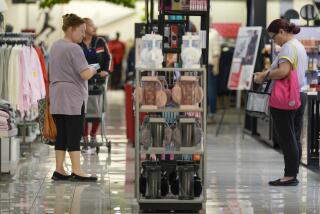2% Consumer Spending Rise Most in Decade
- Share via
WASHINGTON — New car financing deals and a strong Christmas shopping season pushed consumer spending up 2% in December, the government reported today. It was the fastest clip in more than a decade, far outpacing a 1.4% increase in personal income and plunging Americans further into debt.
The Commerce Department said the rise in personal consumption spending was the most since a 2.5% increase in May, 1975.
While the big gain in spending outpaced the rise in income, the 1.4% earnings increase was still the best performance since a 1.5% rise in January, 1984.
Called Healthy Signal
At the White House, presidential spokesman Larry Speakes said, “We would expect the rise in personal income and spending to signal a strong first quarter for the nation’s economy.”
With spending rising faster than income, the personal savings rate dipped to 3.7%, down from 4.2% in November but still above the all-time low of 2.8% set in September.
But for the year, the savings rate averaged 4.6%, the lowest since a 3.9% rate in 1949.
The low savings rate resulted from the fact that Americans’ spending outpaced their income gains last year.
Personal income rose 5.9% last year but personal consumption spending was up 6.6% for the year. Both these figures represented declines from 1984, when personal income shot up by 9.7% while personal spending rose by 8.7%.
After-Tax Income Up 4.9%
Disposable, or after-tax, income rose a modest 4.9% in 1985. This was sharply down from the 10.1% increase in 1984 and was in fact the smallest rise in disposable income since a 4.2% gain in 1961.
Part of the reason for the weak gain in disposable income was a big rise in personal tax payments last year, an 11.6% increase that was the largest since a 15.5% rise in 1981.
By category, wages and salaries rose at a strong annual rate of $18.9 billion in December with one of the strongest performances coming from a $4.4-billion increase in manufacturing payrolls after a decline of $400 million in November.
More to Read
Inside the business of entertainment
The Wide Shot brings you news, analysis and insights on everything from streaming wars to production — and what it all means for the future.
You may occasionally receive promotional content from the Los Angeles Times.










